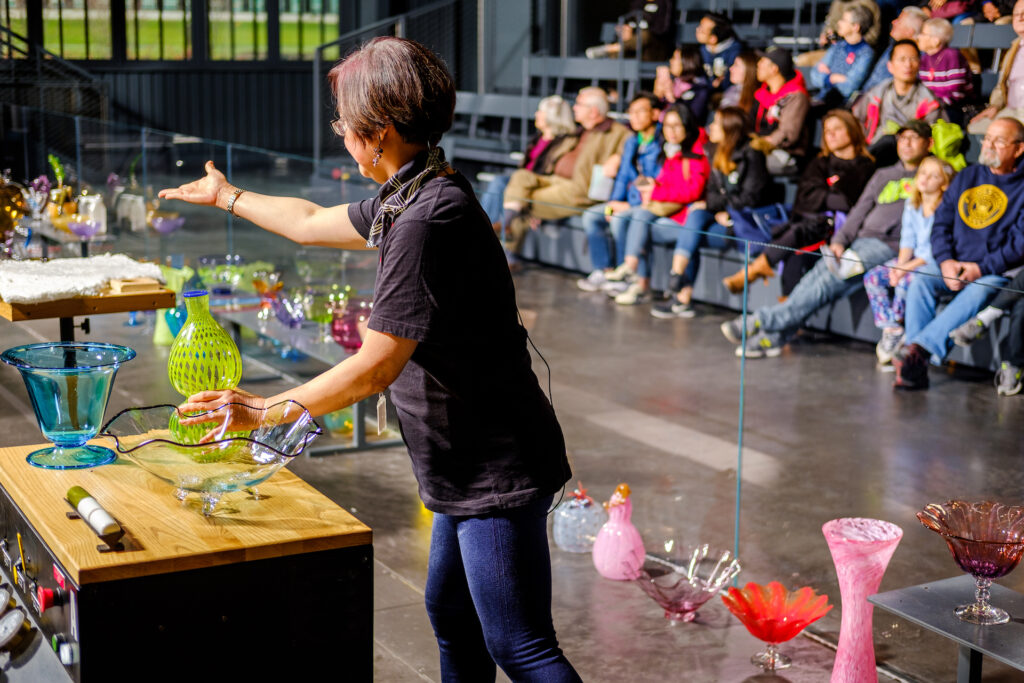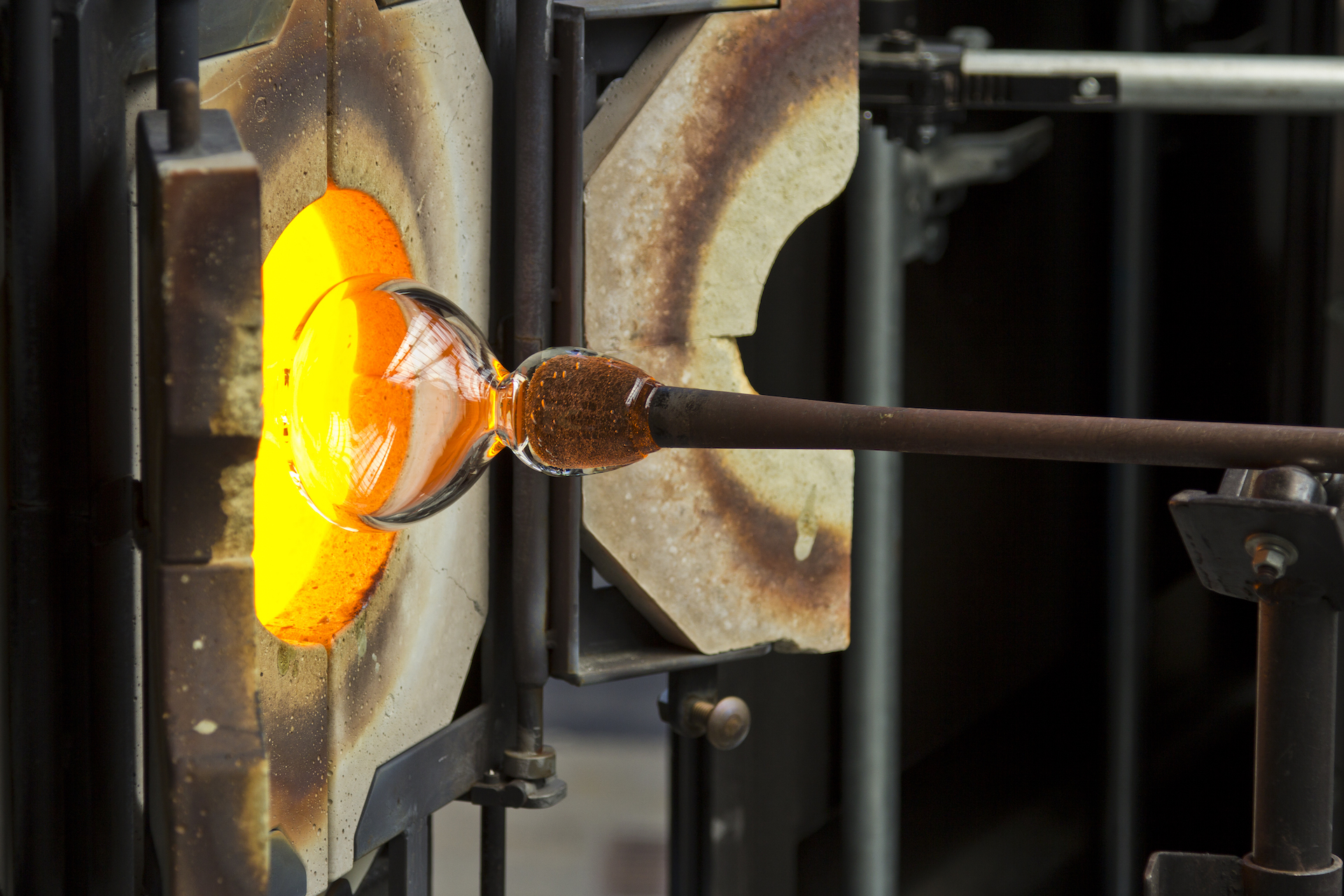Typically, Brooklyn cafés fit a certain mold — carefully curated spaces where hipsters hang while enjoying free Wi-Fi with the brightest espresso or an electrifying cold brew. But in one Williamsburg haunt, where, true to form, tattooed baristas sport neon beanies despite the oppressive mid-August heat, customers are oddly enough entranced by the latest Netflix series, Blown Away, as they enjoy their avocado toasts and turmeric lattes.
For the uninitiated, Blown Away is like The Great British Bake Off but for glassblowing, with contestants using furnaces eight times hotter than the temperature of your standard cake baking oven, and where the winner, besides being bestowed with the glorious title of the “Best in Blow,” gets a much-coveted residency at the Corning Museum of Glass (CMoG), a world-famous museum located in the grasp of the Finger Lakes in New York State.
The success of Blown Away has caused an uptick in visitors to the museum as well as the inevitable social media boost — publicity that has come at just the right time. The CMoG is experiencing a worrying decline in Chinese visitors, a group that constitutes a quarter of all guests.
The museum’s reliance on Chinese money is surprising and owes much to geography; en route to Niagara Falls from New York City and Washington D.C., the world’s largest museum of glass art and artifacts has capitalized on the Chinese tour bus market by becoming an essential pit stop for tourists to stretch their legs, refuel and, quite naturally, learn about glass.
In the first 10 years of the century, China’s middle class grew from 2 to 13 percent and with new levels of comfort came a desire travel internationally. By 2006, the year CMoG began to hone its China-strategy, half a million Chinese tourists were traveling in the U.S., and while the number is dwarfed by the 3.2 million Chinese that visited in 2018, Corning maximized its reach to ensure that those who came had comfortable, enriching experiences.
The wealth of history that resides within this rural corner of Upstate New York made convincing East Coast bus companies to make a 90-minute stop a relatively simple proposition. After relocating from Brooklyn in the 1860s, Corning Glass Works (now known as Corning Inc.) has long been a pioneer in the world of glass; it manufactured Thomas Edison’s lightbulb in 1879, the screens for the first generation of iPhones 125 years later, and is currently developing smart glass for the cars of tomorrow.
While CMoG is now a separate, not-for-profit entity, it takes on this enterprising mantle. This becomes evident when Melissa Rose, Group Sales Manager at CMoG, describes the determined steps the museum has taken to become what she calls “China-ready”. CMoG forged strong connections with Chinese travel operators and tourism groups such as New York’s I Love NY and Wine Water and Wonders of Upstate NY. Equally important was providing an in-house experience to suit the needs of the Chinese tourist — efforts that have made the Corning museum arguably the most China-friendly museum anywhere in America.
A quick glance around the museum’s cafeteria proves the point. Overhead screens translate everything from cappuccinos to cups of soup into Mandarin, the noodle station changes its offerings daily, and the Chinese travel essential of hot water is dispensed from a sleek tap by the refrigerators. The cafeteria is only the starting point. Corning provides Chinese maps, APPs, social media, and payment – UnionPay, China’s most commonly held credit card. But the museum truly excels with its Chinese language tours.
“Having Mandarin speakers on staff is one of the biggest surprises to our Chinese visitors,” says Mickey Dann, a Communications Associate at CMoG, “it’s unusual given the part of the world we are in. But we believe it helps the experience.”
The museum employs a team of Mandarin speakers to guide visitors through the intricacies of Egyptian mold blowing techniques, the secrets of Venetian glass, and the science behind glass formations that occur in the natural world. One such guide is Hsiao-Ying Tiao Shih, a vivacious Taiwan-native who has been leading Chinese-language tours for more than five years. Attend any of the numerous daily glassblowing demonstrations and you’ll see Shih mic’d up and explaining glory holes (furnaces for reheating glass), punties (metal rods used for glass blowing) and annealers (ovens for cooling glass) in the world’s largest hot shop.

Hsiao-Ying Tiao Shih, CMoG’s lead Chinese narrator/interpreter in action at a hot glass demonstration. At the height of the summer tourism season, the museum runs up to 50 such workshops. Image: Courtesy of The Corning Museum of Glass
CMoG has developed the hot glass demonstration into a perfect 30-minute spectacle. With accompanying narration, audiences watch artists take a glowing gob of molten glass and craft a complete piece of art — with the help of a gaffer of course. Shi’s role is less translator and more performer and she has Chinese visitors totally engrossed as the on-stage maestros roll, dip, and blow glass into shape. Understandably, the free giveaways at the end of each demonstration go down a treat.
CMoG’s appeal to Chinese visitors has also extended to bolstering its collection of Qing dynasty glassware, the period representing China’s greatest level of technological and aesthetic achievement. As Jack Wang, a five-year tour guide for Jupiter Legend, explains, growing national pride and a shortage of outstanding glasswork in Chinese museums make Corning particularly appealing.
“Chinese visitors really like the museum,” says Wang, “there’s a lot worth seeing, but they most appreciate the Chinese collection, we don’t have much old glasswork in China and in the end, they are most interested in learning about the history and the art of China.”
Despite CMoG’s China smart strategy, the factors curbing the number of Chinese visitors are somewhat beyond its control. Visa applications are being rejected by U.S. authorities at increasingly higher rates, geo-political animosity between the two countries is influencing the desirability of an American vacation, and the depreciation of the Yuan against the Dollar furthers the U.S.’s unfavorability.
“This year has not been busy enough,” Wang says, “a lot of people got stuck because of visa problems and this is a big change from the past.” To compensate, Jupiter Legend has begun focusing on tapping into another developing outbound tourism market; India. Many of the tours Wang now leads are a fifty-fifty split of tourists from the world’s two most populous countries. Likewise, Rose has seen rejection rates for first-time visa applicants shoot to 40 to 50 percent and is understandably worried about the situation.
“We get a fair few FIT [Free Independent Travelers] arriving in sprinter vans and small groups,” Rose says while acknowledging the numbers are not enough to compensate for the steady flow of tour buses that the museum has come to rely on.
To overcome the decline in tour bus groups, the Corning Museum of Glass must attract more FIT and self-driving Chinese, a less than straightforward task, but one which could be highly lucrative given such travelers typically stay longer and spend more than whistle-stop tour bus groups.
The Li family is one such example. It stopped in Corning on the drive to Niagara Falls and Mrs. Li was impressed by the extensive activities on offer at the Corning Museum of Glass, “it’s educational for my Children, there’s the glass breaking demonstration, there’s sandblasting, so much for them to do.”
Corning’s two-day ticket and free entrance for those under 17 is part of a bid to advertise the museum as part of a broader experience. And there’s no shortage of local activities. Across the Chemung River, Corning charms visitors with its red brick storefronts on Main Street including cozy antique shops and restaurants serving up farm-to-table fare. Options further afield are equally appealing, as Beth Duane, CMoG’s Director of Marketing & Community Relations explains, “we want to do better in the FIT market, we want them to spend a night or two in Corning, to visit our museum, and then go for a hike in Watkins Glen State Park, go to the wineries and the cideries.”
And what better spark to encourage more Chinese FITs to visit the Corning Museum of Glass than second season of Blown Away. The first, after all, was translated into Mandarin. While there’s no word yet on a second season, it’s not hard to image the dramatic appeal of filming the finale in the world’s biggest hot shop.



